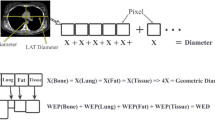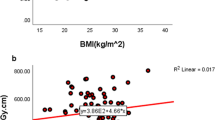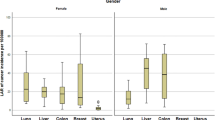Abstract
Objectives
To estimate (a) organ doses and organ-specific radiation-induced cancer risk from a single low-dose CT (LDCT) for lung cancer screening (LCS) and (b) the theoretical cumulative risk of radiation-induced cancer for a typical cohort to be subjected to repeated annual LCS LDCT.
Methods
Sex- and body size-specific organ dose data from scan projection radiography (SPR) and helical CT exposures involved in LCS 256-slice LDCT were determined using Monte Carlo methods. Theoretical life attributable risk (LAR) of radiogenic cancer from a single 256-slice chest LDCT at age 55–80 years and the cumulative LAR of cancer from repeated annual LDCT studies up to age 80 years were estimated and compared to corresponding nominal lifetime intrinsic risks (LIRs) of being diagnosed with cancer.
Results
The effective dose from LCS 256-slice LDCT was estimated to be 0.71 mSv. SPR was found to contribute 6–12 % to the total effective dose from chest LDCT. The radiation-cancer LAR from a single LDCT study was found to increase the nominal LIR of cancer in average-size 55-year-old males and females by 0.008 % and 0.018 %, respectively. Cumulative radiogenic risk of cancer from repeated annual scans from the age of 55–80 years was found to increase the nominal LIR of cancer by 0.13 % in males and 0.30 % in females.
Conclusion
Modern scanners may offer sub-millisievert LCS LDCT. Cumulative radiation risk from repeated annual 256-slice LDCT LCS examinations was found to minimally aggravate the lifetime intrinsic cancer risk of a typical screening population.
Key Points
• Effective dose from lung cancer screening low-dose CT may be <1 mSv.
• Screening with modern low-dose CT minimally aggravates lifetime cancer induction intrinsic risk.
• Dosimetry of lung cancer screening low-dose CT should encounter the radiation burden from the localizing scan projection radiography.
• DLP method may underestimate effective dose from low-dose chest CT by 27 %.


Similar content being viewed by others
Abbreviations
- BMI:
-
Body mass index
- CTDI:
-
Computed tomography dose index
- DLP:
-
Dose-length product
- ICRP:
-
International Commission on Radiological Protection
- L:
-
Lateral
- LAR:
-
Life-attributable risk
- LCS:
-
Lung cancer screening
- LDCT:
-
Low-dose CT
- LIR:
-
Life intrinsic risk
- P:
-
Posterior-anterior
- SPR:
-
Scan projection radiograph
References
Murugan VA, Kalra MK, Rehani M, Digumarthy SR (2015) Lung Cancer Screening: Computed Tomography Radiation and Protocols. J Thorac Imaging 30:283–289
Henschke CI, McCauley DI, Yankelevitz DF et al (1999) Early Lung Cancer Action Project: overall design and findings from baseline screening. Lancet 354:99–105
Sonavane SK, Pinsky P, Watts J et al (2017) The relationship of cancer characteristics and patient outcome with time to lung cancer diagnosis after an abnormal screening CT. Eur Radiol 27:5113–5118
Aberle DR, Adams AM, Berg CD et al (2011) Reduced Lung-Cancer Mortality with Low-Dose Computed Tomographic Screening. N Engl J Med 365:395–409
American Lung Association (2015) Providing guidance on lung cancer screening to patients and physicians. An update from the American Lung Association Screening Committee
National Comprehensive Cancer Network (2007) NCCN Guidelines for Patients: Lung Cancer Screening, Version 1
Moyer VA (2014) Screening for Lung Cancer: U.S. Preventive Services Task Force Recommendation Statement. Ann Intern Med 160:330–338
Kauczor HU, Bonomo L, Gaga M et al (2015) ESR/ERS white paper on lung cancer screening. Eur Radiol 25:2519–2531
McWilliams A, Tammemagi MC, Mayo JR et al (2013) Probability of cancer in pulmonary nodules detected on first screening CT. N Engl J Med 369:910–919
Brenner DJ (2004) Radiation risks potentially associated with low-dose CT screening of adult smokers for lung cancer. Radiology 231:440–445
Prokop M (2005) Cancer screening with CT: dose controversy. Eur Radiol 15:D55–D61
McCunney RJ, Li J (2014) Radiation Risks in Lung Cancer Screening Programs. Chest 145:618–624
McCunney RJ, Li J (2014) Radiation risks in lung cancer screening programs: a comparison with nuclear industry workers and atomic bomb survivors. Chest 145:618–624
Deak PD, Smal Y, Kalender WA (2010) Multisection CT protocols: Sex- and age-specific conversion factors used to determine effective dose from dose-length product. Radiology 257:158–166
American Association of Physicists in Medicine (2011) Size-specific dose estimates (SSDE) in pediatric and adult body CT examinations. Report of AAPM Task Group 204, College Park, MA, USA
Brenner DJ (2008) Effective dose: a flawed concept that could and should be replaced. Br J Radiol 81:521–523
International Commission on Radiological Protection (2007) Managing Patient Dose in Multi-Detector Computed Tomography (MDCT). ICRP Publication 102. Ann ICRP 37(1)
Kalender WA (2014) Dose in x-ray computed tomography. Phys Med Biol 59:R129–R150
Perisinakis K, Tzedakis A, Spanakis K, Papadakis A, Hadzidakis A, Damilakis J (2017) The effect of iodine uptake on radiation dose absorbed by patient tissues in contrast enhanced CT imaging: Implications for CT dosimetry. Eur Radiol 28:151–158
Committee to Assess Health Risks from Exposure to Low levels of Ionizing Radiation (2006) Health Risks from Exposure to low Levels of Ionizing Radiation: BEIR VII Phase 2. The National Academy Press, Washington, DC
International Commission on Radiological Protection (2007) The 2007 Recommendations of the International Commission on Radiological Protection. ICRP publication 103. Ann ICRP 37
American Association of Physicists in Medicine (2008) The measurement, reporting and management of radiation dose in CT. Report of AAPM task group 23, College Park, MA, USA
Rampinelli C, De Marco P, Origgi D et al (2017) Exposure to low dose computed tomography for lung cancer screening and risk of cancer: secondary analysis of trial data and risk-benefit analysis. BMJ 356:j347
Lell MM, Wildberger JE, Alkadhi H, Damilakis J, Kachelriess M (2015) Evolution in Computed Tomography: The Battle for Speed and Dose. Invest Radiol 50:629–644
Moser JB, Sheard SL, Edyvean S, Vlahos I (2017) Radiation dose-reduction strategies in thoracic CT. Clin Radiol 72:407–420
Tzedakis A, Damilakis J, Perisinakis K, Stratakis J, Gourtsoyiannis N (2005) The effect of z-overscanning on patient effective dose from multi-detector spiral computed tomography examinations. Med Phys 32:1621–1629
Deak PD, Langner O, Lell M, Kalender WA (2009) Effects of adaptive section collimation on patient radiation dose in multisection spiral CT. Radiology 252:140–147
Boone JM, Seibert JA (1997) An accurate method for computer-generating tungsten anode x-ray spectra from 30 to 140 kV. Med Phys 24:1661–1670
National Heart, Lung, and Blood Institute (2000) The Practical guide for identification, evaluation and treatment of overweight and obesity in adults, NIH Publication No. 00-4084
International Commission on Radiological Protection (1996) Conversion coefficients for use in radiological protection against external radiation. ICRP publication 74. In Ann ICRP 26
Howlader N, Noone AM, Krapcho M et al (2017) SEER Cancer Statistics Review, 1975-2014. National Cancer Institute, Bethesda, MD
Aberle DR, Adams AM, Berg CD et al (2010) Baseline characteristics of participants in the randomized national lung screening trial. J Natl Cancer Inst 102:1771–1779
Lee C, Flynn MJ, Judy PF, Cody DD, Bolch WE, Kruger RL (2017) Body Size-Specific Organ and Effective Doses of Chest CT Screening Examinations of the National Lung Screening Trial. AJR Am J Roentgenol 208:1082–1088
Messerli M, Kluckert T, Knitel M et al (2017) Ultralow dose CT for pulmonary nodule detection with chest x-ray equivalent dose - a prospective intra-individual comparative study. Eur Radiol 27:3290–3299
Jacobs CD, Jafari ME (2017) Early Results of Lung Cancer Screening and Radiation Dose Assessment by Low-dose CT at a Community Hospital. Clin Lung Cancer 18:e327–e331
Miao Z, Weiwei Q, Ye S, Yan J, Xiaoyi L, Hong N (2017) Screening for Lung cancer using sub-millisievert chest CT with iterative reconstruction algorithm: image quality and nodule detectability. Br J Radiol 20170658. l
Schmidt BT, Hupfer M, Saltybaeva N, Kolditz D, Kalender WA (2017) Dose Optimization for Computed Tomography Localizer Radiographs for Low-Dose Lung Computed Tomography Examinations. Invest Radiol 52:81–86
Rodrigues JC, Negus IS, Manghat NE, Hamilton MC (2013) A completed audit cycle of the lateral scan projection radiograph in CT pulmonary angiography (CTPA); the impact on scan length and radiation dose. Clin Radiol 68:574–579
Hendee WR, O'Connor MK (2012) Radiation risks of medical imaging: separating fact from fantasy. Radiology 264:312–321
Funding
The authors state that this work has not received any funding.
Author information
Authors and Affiliations
Corresponding author
Ethics declarations
Guarantor
The scientific guarantor of this publication is Kostas Perisinakis.
Conflict of interest
The authors of this manuscript declare no relationships with any companies, whose products or services may be related to the subject matter of the article.
Statistics and biometry
No complex statistical methods were necessary for this paper.
Informed consent
Written informed consent was not required since the study was not on human subjects
Ethical approval
Not applicable.
Methodology
• prospective
• experimental
• performed at one institution
Rights and permissions
About this article
Cite this article
Perisinakis, K., Seimenis, I., Tzedakis, A. et al. Radiation burden and associated cancer risk for a typical population to be screened for lung cancer with low-dose CT: A phantom study. Eur Radiol 28, 4370–4378 (2018). https://doi.org/10.1007/s00330-018-5373-7
Received:
Revised:
Accepted:
Published:
Issue Date:
DOI: https://doi.org/10.1007/s00330-018-5373-7




